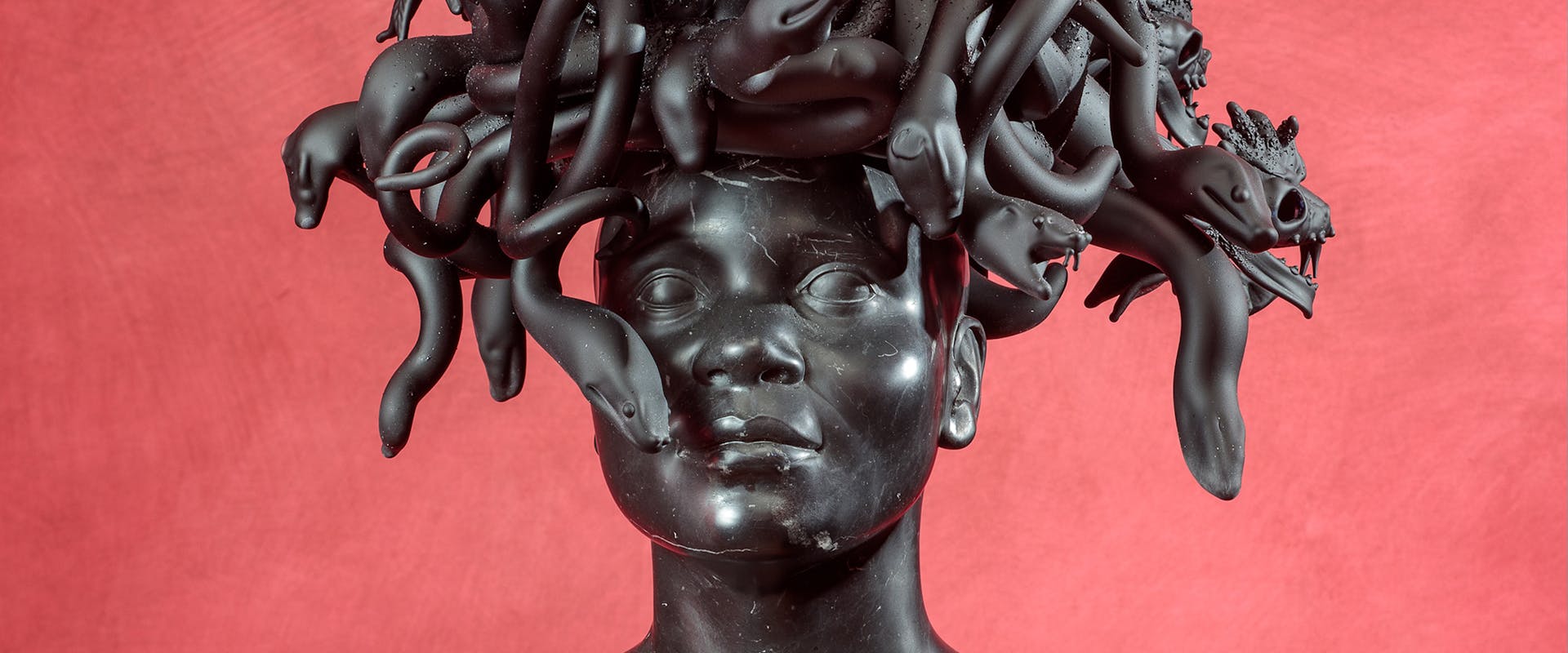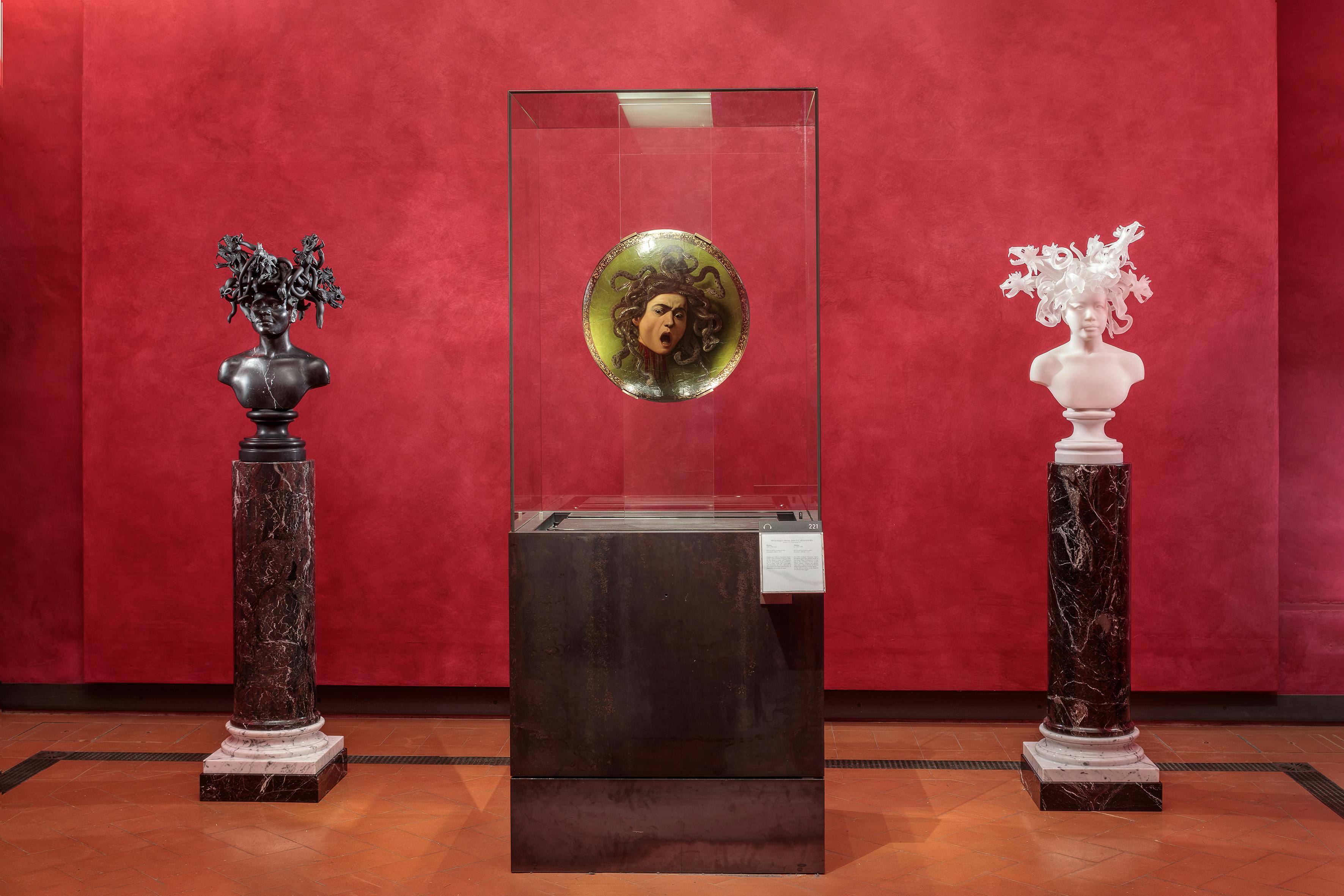Seduzione. Koen Vanmechelen
The fantastical creatures of the belgian artist Koen Vanmechelen at the Uffizi
Huge horned iguanas, a red tiger crouching in the middle of the Niobe room, new versions of the Medusa with her head teeming with hybrid figures that feature bizarre beaks and sharp teeth: a veritable legion of fantastical creatures populate the Uffizi in Seduzione, an exhibition by Belgian artist Koen Vanmechelen, presented in the Gallery of Statues and Paintings, from 18 January to 20 March. The exhibition, which opens the Uffizi’s 2022 season, includes 30 artworks, presented among the museum's masterpieces. Vanmechelen’s works carry a strong visual and conceptual impact, that will accompany visitors from the entrance, along the corridors on the second floor, to the room of the so-called ‘ricetto delle iscrizioni’, in-between that of Leonardo and of Raphael and Michelangelo to the rooms of Caravaggio and the Flemish Painters that conclude the itinerary on the first floor.
Vanmechelen’s practice embraces a wide range of disciplines, bridging the realms of art, science, and community engagement. A painter, sculptor, performer, and philosopher, his interests range from anthropology to bioethics, from the protection of human rights to bio-genetics, and to concepts relating to hybridization (among animal and plant species) and contamination (within culture and nature as well as in formal and conceptional expression). The works in the exhibition, which were created especially for the Uffizi, focus on the primordial, archetypal, and antithetical concepts that have always nourished the human imagination: life-death, human-divine, earthly-spiritual, natural-artificial. Presented in dialogue with the works in the Uffizi’s collection, they create an evocative and disorienting journey around the idea of 'seduction': together offering a kind of hymn to the power of life and the regenerating, although sometimes monstrous, force of the natural world.
In the corridors of the Uffizi’s second floor, among the classical statuary, the white Statuario marble sculptures of Vanmechelen’s Temptation series depict emperors, philosophers, warriors, heroes, and divinities. Atop each figure is a cracked glass egg from which hybrid creatures spring forth, representing the freeing of the mind and its imagination. The works capture Vanmechelen’s vision for encouraging the development of new philosophies, ideas, and approaches that could herald new and better futures. Another intriguing juxtaposition within the exhibition includes the Bambino con Gallo, a plaster cast by the 19th-century Florentine artist Adriano Cecioni (normally on display at the Galleria d'Arte Moderna in Palazzo Pitti, but for this occasion 'transferred' to the Uffizi), with Vanmechelen’s Cosmopolitan Fossil. Inspired by Cecioni, Vanmechelen transforms the innocent bird featured in the historic work into an enormous iguana characterized by disturbing mutations, barely restrained by the child who holds it in his hands. Cosmopolitan Fossil references the futile effort by humanity to control the unstoppable forces of nature and is intended to encourage a more loving and healing embrace of the wider natural ecosystem. This is a particularly salient and poignant piece in context of our ongoing pandemic.
The installation Domestic violence also plays with contrasts, both material and psychological: a life-size tiger in red marble lies on a carpet of chicken feathers in the centre of the famous room containing the Hellenistic sculpture group of the Niobids. A sharp saber pierces the tiger’s back as a tragic reference to the desperate gestures of the figures in the ancient statues. The feline is particularly striking for its meekness and serenity, which is completely at odds with the dramatic atmosphere of its surroundings. An image of the artist himself also appears in the exhibition: the self-portrait Ubuntu, (a Diasec face mount print to acrylic, exhibited in the self-portraits room), shows him in a coat of chicken feathers (a reference to his ongoing, critically acclaimed Cosmopolitan Chicken Project), observing the visitor through a glass mask. Ubuntu, in the Bantu language, means " I am because we are." The title is an invitation to embrace the principle of this South African philosophy and a reminder that each of us is tied to a community of other people and nature. With the conclusion of the exhibition, the work will be donated by the artist to the museum. Seduzione also includes a pair of hybrid Medusa made of marble and glass, positioned in the main Caravaggio room: their heads, bristling with snakes and the skulls of monstrous mutagenic chickens with their sharp jaws wide open, flank and enhance the horror of the snake hair that frames the distorted face of Michelangelo Merisi's masterpiece. Like the venom of Medusa and her snakes, which in mythology held the power to awaken the dead, chicken eggs are also used in modern medicine as the basis for medicines and vaccinations. Medusa is therefore a metaphor for the ability to kill as well as to give new life.
The director of the Uffizi Eike Schmidt: "Vanmechelen's works seem to fit naturally into the historical collection, creating hybrids between the ancient model and contemporary expression, in ways that are similar to the biological hybridization that the artist has been personally practicing for decades in the field of nature, among various species of poultry. The image of the chicken thus becomes an avatar and mirror of man, as in Diogenes' famous commentary on Plato. In this way, artistic creation is read in an ecological key (and vice versa: nature becomes art) opening up perspectives of pressing relevance".
Artist Koen Vanmechelen: 'In this moment, in the Anthropocene, we need a new global renaissance. We need a Cosmopolitan Renaissance. This new narrative must be based on an understanding of the interconnectedness of all living beings. The parallel with the Italian Renaissance is clear. Art, being designed for the future, is the way to foster and project new narratives in the world. Art has always been the connective tissue of human existence. It clarifies, opens perspectives, and connects us through diversity. It aspires to sow Ubuntu, a Bantu term that refers to the belief in a universal bond of sharing that connects all humanity. This realization comes from seeing the reflection of your self-image in the other, an image that is the bearer of the past and the future”.
The exhibition catalogue, published by Giunti and soon to be available in Italian and English editions, presents contributions by the curators, the artist, and Jorge Fernandez, Mario Botta, Chido Govera, and Adriano Berengo. The exhibition is organized and produced by the Uffizi Galleries with Studio Vanmechelen and Fondazione Berengo.
Biographical notes on the artist
Koen Vanmechelen, born on 26 August 1965 in Sint-Truiden, Belgium, is a multidisciplinary artist who began his career in the early 1990s. At the centre of his work is the concept of biocultural diversity, investigated through the domestic chicken and the primitive species from which it is derived. Identity, diversity, globalization and human rights are the topical issues that intertwine in the realization of his projects. From his first wooden sculptures in the 1980s, to the development of the Cosmopolitan Chicken Project, a vast research programme aimed at generating new breeds of poultry, to the recent creation of an immense park called Labiomista (where large-scale architecture and natural landscape installations, works of art and animals of the most diverse species coexist), Vanmechelen's art aims to be both an ethical and an aesthetic expression. In 2010, he received an honorary doctorate from the University of Hasselt, and in 2013, he received the prestigious Golden Nica Hybrid Art Award (Linz) and the Global Artist's Award (Venice). To date, his work has been shown in more than 80 solo and 220 group exhibitions worldwide. He was a speaker at the World Economic Forum in 2008.

